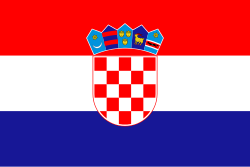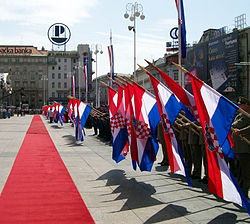- Standard of the president of the Republic of Croatia
This article needs additional citations for verification .(October 2012) |
 | |
| Trobojnica (Tricolor) Crven-bijeli-plavi (Red-white-blue) | |
| Use | National flag |
|---|---|
| Proportion | 1:2 |
| Adopted | 1868 (original design) 1939 (checkerboard shield added) December 21, 1990 (current form) June 25, 1991 (official adoption as national independent flag) |
| Design | A horizontal tricolor of red, white, and blue anchored by the national coat of arms. |
| Designed by | Miroslav Šutej [1] |
 | |
| Use | Civil and state ensign |
| Proportion | 2:3 |
| Adopted | 1992 |
| Design | Three equal horizontal bands of red (top), white and blue superimposed by the Coat of arms of Croatia. |
 | |
| Use | Naval ensign |
| Proportion | 2:3 |
| Adopted | 1992 |
| Design | Three equal horizontal bands of red (top), white and blue superimposed by the emblem of the Croatian Navy. |
The national flag of the Republic of Croatia, also known in Croatian as the Tricolor (Trobojnica) or the Red-white-blue (Crven-bijeli-plavi), is one of the state symbols of Croatia. It consists of three equal size, horizontal stripes in colors red, white and blue anchored by the coat of arms of Croatia.
Contents
- History
- Shield
- Design
- Unicode
- Historical flags
- Other official flags in Croatia
- Naval and other official flags
- Commemoration
- Gallery
- See also
- References
- External links
This flag has been continuously in use since 1868 using pan-Slavic colors with the white and red checkboard shield added from 1939; which was then replaced by a red star during communist rule before the modern iteration of the Croat flag was adopted in 1990, one year before its independence.











































